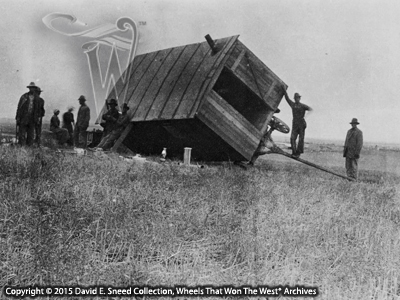I once had a team of draft horses that wereunpredictable and took spells of nervous behavior. They were great fun to drive but it was hardto tell what might set them off. Onefall day, I had hitched them to an old John Deere wagon. I had been working them for about two hoursand was rolling through the middle of an open 40 acre field. The day was cool but comfortable and all hadbeen going well. As I contemplatedheading back to the barn, something stirred in the brain of the nearwheeler. Whether it was his imaginationor some reality that I hadn’t noticed really didn't matter. Both horses took flight and I found myself on aride that connected me firsthand to a part of our horse drawn heritage mostwould like to avoid.
In an instant, the serenity of themoment was exchanged for a time of rapt attention and rapid deliberations. I’ve heard folks say that the human mindcan’t ponder multiple thoughts at the exact same time but that day may havebeen an exception. The next severalminutes seemed like an eternity with plenty of contemplations being hastily tossedaround in my head.
I don’t know how long the run-awaylasted but, as I slid sideways around the perimeter of a large circle, Iremember seeing good-sized chunks of grass and dirt being cut by the tires and thrown highinto the air. I kept the team turned asmuch as possible and when they finally stopped, it was hard to tell who wastrembling the most – me or the horses. Thenext surprise happened when I looked down from my precarious perch. It appeared that the wagon was quite a bit longerthan it had been when I started. Ofcourse, that didn’t make sense but as I climbed down, I quickly noticed the pinhad popped out of the reach and allowed the rear half of the running gear toslide along the coupling pole leaving only few inches before the gear extended beyond the box. Thankfully, we had stopped just in time toprevent the wagon from coming apart at full stride. (Moral of the story - always check to make sure the reach pin has a cotter key securely attached and do an overall vehicle safety review before hitching up!)
 |
| Surrounded by members of a threshing crew, this lunch wagon may have fallen victim to heavy winds on the plains. |
To the point about parts, early vehiclebuilders knew the dangers of broken or weakened components. As a result, many designs were created to enhancethe performance of a set of wheels while adding to the peace of mind andconfidence of the user. For example, sinceking bolts were a crucial part subjected to tremendous stresses, many of thesesections received extra reinforcement as did the associated areas on theforward axle and sand board. Reacheswere likewise engineered to help eliminate wear or rotate in response tochanging terrain. Some brakes weredesigned to self-engage when going downhill, aiding with the load on draftanimals and helping prevent skittish teams from running when they felt thewagon pushing them. Steering systems(much like some early autos) were developed to help minimize injuries to horsesfrom a tongue whipping to one side or another after hitting a rock or hole. Some manufacturers even had speciallydesigned pole caps that minimized the chances of neck yokes accidentallyslipping off of the tongue.
 |
| In this exclusive original photo from the Wheels That Won The West® Archives, these tall-sided western freighters are being set upright after overturning on a narrow mountain road. |
There were countless innovations andfeatures especially designed for the well-being of the vehicle passengers anddraft animals. Some of these traits havebeen covered in this blog while many more are deserving of discussions aswell. Even the types of wood used inparticular areas were often chosen for their safety and security points. Historically, the designed safety features ofearly wagons and western vehicles have not received a lot of publicity. Nonetheless, it was an area that many manufacturersfocused on and one that gives us great insight into the unique characteristicsthat helped set individual makers – and even different eras – apart from each other.
Please Note: As with each of our blog writings, all imagery and text is copyrighted with All Rights Reserved. The material may not be broadcast, published, rewritten, or redistributed without prior written permission from David E. Sneed, Wheels That Won The West® Archives.